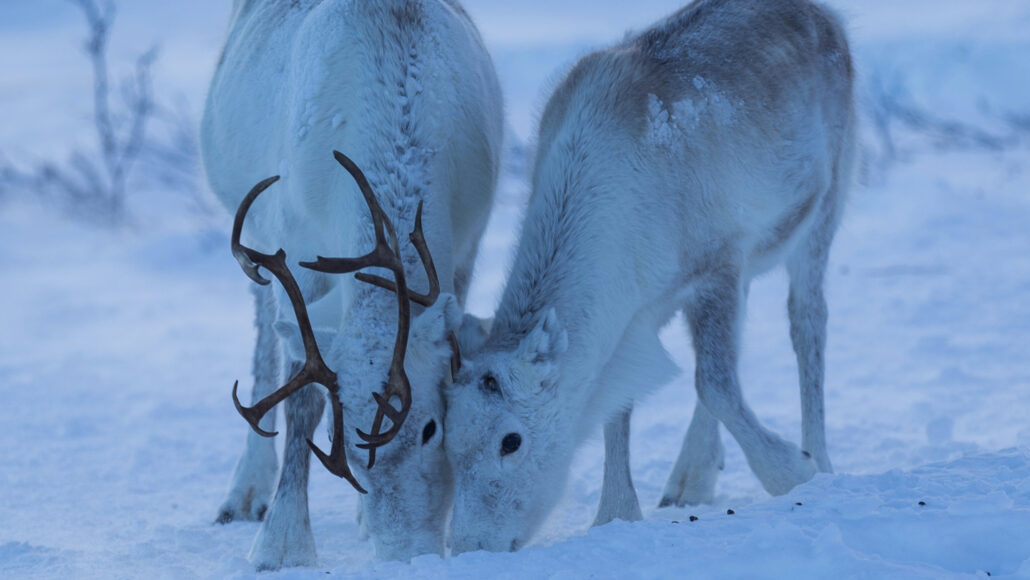Reindeer can chew food in their sleep
Multitasking may help these animals get shuteye under tough conditions

Arctic reindeer make time for digesting by doing some of it as they sleep, new research suggests.
Frank Meissner
Animals have developed many impressive techniques to sleep under tough conditions. Some seals sleep while diving deep below predators. Frigate birds sleep in the air during long-haul flights. Now, a new study finds that reindeer can sleep while eating.
Researchers shared the finding on January 22 in Current Biology.
Arctic reindeer live in the far North. There, the sun can shine around the clock in summer. At that time of year, food is abundant — and Arctic reindeer get busy eating it. Like other ruminant animals, reindeer spend a lot of time chewing regurgitated food, called cud. (Spitting up and re-chewing food makes it smaller and easier to digest.)
Finding time to sleep amid all this cud chewing might be tough. But not if reindeer could sleep as they chewed.
Melanie Furrer and Sara Meier wanted to know if this was possible. Both scientists work at the University of Zurich in Switzerland. Furrer is a neuroscientist, who studies brain activity. Meier is a chronobiologist — someone who studies body rhythms, like sleep cycles.
Furrer and Meier were part of a team that worked with four female Eurasian tundra reindeer (Rangifer tarandus tarandus). The researchers trained the reindeer to tolerate electrodes glued onto shaved patches of skin. Those electrodes measured the animals’ brain activity.
Training the reindeer wasn’t easy. The animals tended to kick. But the researchers gave the reindeer lots of lichen treats. Says Meier, it’s “like candy to them.”
Electrodes detected brain waves typical of non-REM sleep when the reindeer were chewing cud. (REM is short for rapid eye movement. Non-REM is a deep, restorative phase of sleep.) The reindeers’ chewing motion made it hard to tell whether the signal was just like that of regular sleep. “We couldn’t go into detail by looking only at the brain waves, because we have this chewing in there that disturbs it a bit,” says Furrer.
Other signs, however, helped confirm the reindeer really were asleep. For one thing, the reindeer were calm while chewing. In fact, they often had their eyes closed. “They were in a very relaxed state that resembles the body position of non-REM sleep,” Furrer notes.
Chewing reindeer also were harder to disturb. They were less likely to look over at noise made by a nearby reindeer. Plus, when reindeer are kept awake, they need catch-up recovery sleep. But time spent chewing decreased how much time they spent in recovery sleep.
Together, these strands of evidence show that reindeer can sleep while chewing, says Niels Rattenborg. This neurobiologist was not involved in the study. He works at the Max Planck Institute for Biological Intelligence. That’s in Seewiesen, Germany.
Some animals, such as dolphins, ducks and frigate birds, sleep with only one side of their brain at a time. But reindeer seem to sleep with both sides of their brains while chewing. Figuring out just how reindeer pull this off would be interesting, Rattenborg says. Studying various forms of sleep might lead to insights on sleep walking in people, he adds. This is “a poorly understood and potentially dangerous sleep disorder.”
Gabi Wagner is a coauthor on the new study. She’s a neuroscientist at the Norwegian Institute of Bioeconomy Research in Tromsø. Indigenous reindeer herders have a concept that roughly translates to “pasture peace,” she notes. The idea is that reindeer “need time and space to be quiet and to have peace” to chew their food. “This paper,” she says, “for the first time shows that this is a very real, physiological requirement.”







